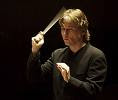
Incidental music for a narration based on a selection of songsby Latozi Mpahlenibetter known as Madosini
Madosini (song, uhadi, umhrubhe, isitolotolo)with clarinet, string quartet and narrator
- commissioned by the ICMF 2002 -
(first performance: 15.8.02, State Theatre, Pretoria)
Madosini is a much cherished but little known amaMpondo musician. She ought really be treated a national living cultural treasure, instead her art is known only to a selected few. She has succeeded not only to preserve but also to continuously be creative in the unique style of traditional amaMpondo music. She is a singer, composer, storyteller and master player of three traditional instruments: uhadi (music bow), umhrubhe (mouth bow) and isistoloto (Jewish Harp).
The Songs of Madosini - a miniature oratorio - aims at celebrating Madosini's art (and thereby one of South Africa's unique traditions!). It is structured around a selection of her songs, which she herself performs live, 'setting' them for a concert situation with the necessary 'translation' or mediation for both audience and soloist, who would not meet under normal circumstances. For neither is Madosini's music originally intended to be performed on a stage, nor will the average South African hardly ever have the opportunity to hear her music - let alone understand it - within it's context.
Thus Madosini's music is complemented by a quintet of clarinet and strings and a narrator. The European instruments formally create a musical frame for the songs, by either accompanying, imitating, commenting or contrasting them. Obviously they also take up the given musical material at times to develop or interpret it in a Western musical idiom, mirroring as it were the two vastly different musical styles. These numerous and varied interactions let the focus change time and again, and thereby constantly offer new ways to access the unfamiliar form of expression, which most probably Madosini's music will constitute to first-time listeners.
Additionally, a narration leads through the piece, connecting the various songs and movements, touching on Madosini's biography and personal circumstances related to the songs. It also translates the lyrics, unveils the contexts of the respective songs and finally becomes self-reflexive, by drawing the attention on the precarious situation of this very form of music, which is on the verge of becoming extinct.
Madosini offers us one of the very last chances to catch a glimpse of Africa's prehistoric musical past. If we succeed to step out of our conventional listening habits and lend her our ears, she treats us with the invaluable experience of a musical expression, which, in its purity and stillness, can best be compared to the quality or athmosphere which untouched pristine landscapes might evoke - such as those, in which similar songs where originally resounding centuries ago. But best of all: Madosini is well and alive; her music is no artificial tradition or dry reconstruction of something gone by. She carries within her a spirit, which is rarely found anymore in these times of cultural reduction into majority-pleasing, artificial main-stream sell-outs, but which deserves all the more to be nurtured by those who care for life's fully abundant, varied and diverse expressions.













No comments:
Post a Comment